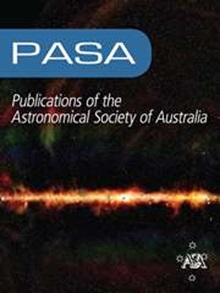圆盘喷流系统中的角动量和能量传输。揭示饱和热传导的贡献
IF 4.6
3区 物理与天体物理
Q1 ASTRONOMY & ASTROPHYSICS
Publications of the Astronomical Society of Australia
Pub Date : 2024-03-21
DOI:10.1017/pasa.2024.23
引用次数: 0
摘要
本研究以我们之前的工作为基础,进一步探索和揭示粘性阻力 MHD 框架内饱和热传导对圆盘喷流系统中错综复杂的角动量和能量传输机制的影响。我们使用 PLUTO 代码进行了一系列 2.5 维非相对论时变数值模拟。采用的饱和参数跨度为[0.002-0.01],我们的结果与之前忽略热传导的研究结果一致,肯定了动力矩在控制总增生角动量中起主导作用的既定认识,超过了圆盘内的磁贡献。在计算的初始时间步,我们发现热传导增强了动能贡献,同时减弱了磁贡献的影响。与圆盘内部动力矩的主要影响相反,我们还断言磁力矩是总抛射角动量的主要贡献者。我们进一步揭示出,饱和参数增加一倍会使磁力矩在射流中的整体主导地位比动能力矩提高约 23.7%。我们的研究结果表明,热传导效应加倍可使整体总增殖功率提高约 2%,从而略微放大系统内的能量含量并增加整体能量输出。我们强调,随着盘内局部能量耗散的加剧,焓增殖通量的重要性会增加,而喷流功率则会降低。我们发现,增加饱和参数可以缓解盘内的焓积累,并进一步限制射流从盘中提取能量。在我们的分析中,这种限制是通过双极射流和释放功率之间的积分比降低约 13.8%(饱和参数强度为两倍)来确定的。我们认为波因廷通量是喷流总功率的主要贡献者,而热传导对磁贡献的影响微乎其微。此外,我们还强调喷流焓是决定总体喷流功率的另一个重要因素,并突出强调了饱和参数上升与焓贡献增加之间的明显相关性。此外,我们还观察到,在模拟的高级时间步中,波因廷通量比动能通量更大,热传导的存在支持了这一趋势,当考虑到饱和参数翻倍时,热传导的积分增加了约 11.2%。本文章由计算机程序翻译,如有差异,请以英文原文为准。
Angular momentum and energy transport in disc–jet systems. Unravelling the contribution of saturated thermal conduction
This study builds upon our prior work to further explore and unravel the effects of saturated thermal conduction within a viscous resistive MHD framework on the intricate transport mechanisms of angular momentum and energy in disc-jet systems. We conducted a series of 2.5-dimensional non-relativistic time-dependent numerical simulations using the PLUTO code. Employing a saturation parameter spanning [0.002-0.01], our results are consistent with previous investigations that omitted consideration of thermal conduction, affirming the established understanding that kinetic torque plays a predominant role in governing the total accretion angular momentum, surpassing the magnetic contribution within the disc. At the initial time-steps of our calculations, we find that thermal conduction enhances this kinetic contribution, while concurrently diminishing the effect of magnetic contribution. In contrast to the prevailing influence of kinetic torque within the disc, we also assert the magnetic torque as the primary contributor to the total ejection angular momentum. We further unveil that doubling the saturation parameter leads to bolstering of approximately 23.7% in the integral dominance of magnetic torque compared to kinetic torque within the jet. Our findings reveal that doubling the effect of thermal conduction improves the integral total accretion power by approximately 2%, thereby slightly amplifying the energy content within the system and increasing overall energy output. We underscore that as the local energy dissipation within the disc intensifies, the significance of the enthalpy accretion flux increases at the expense of the jet power. We reveal that increasing the saturation parameter mitigates enthalpy accumulation within the disc, and further restricts the jet’s energy extraction from the disc. This limitation is determined in our analysis through the decrease in the integral ratio between the bipolar jet and liberated power of approximately 13.8%, for twice the strength of the saturation parameter. We identify the Poynting flux as the primary contributor to total jet power, with thermal conduction exerting minimal influence on magnetic contributions. Additionally, we emphasise the integration of jet enthalpy as another significant factor in determining overall jet power, highlighting a distinct correlation between the rise in saturation parameter and heightened enthalpy contribution. Moreover, we observe the promotion of Poynting flux over kinetic flux at advanced time-steps of our simulations, a trend supported by the presence of thermal conduction, which demonstrates an integral increase of approximately 11.2% when considering a doubling of the saturation parameter.
求助全文
通过发布文献求助,成功后即可免费获取论文全文。
去求助
来源期刊
CiteScore
5.90
自引率
9.50%
发文量
41
审稿时长
>12 weeks
期刊介绍:
Publications of the Astronomical Society of Australia (PASA) publishes new and significant research in astronomy and astrophysics. PASA covers a wide range of topics within astronomy, including multi-wavelength observations, theoretical modelling, computational astronomy and visualisation. PASA also maintains its heritage of publishing results on southern hemisphere astronomy and on astronomy with Australian facilities.
PASA publishes research papers, review papers and special series on topical issues, making use of expert international reviewers and an experienced Editorial Board. As an electronic-only journal, PASA publishes paper by paper, ensuring a rapid publication rate. There are no page charges. PASA''s Editorial Board approve a certain number of papers per year to be published Open Access without a publication fee.

 求助内容:
求助内容: 应助结果提醒方式:
应助结果提醒方式:


